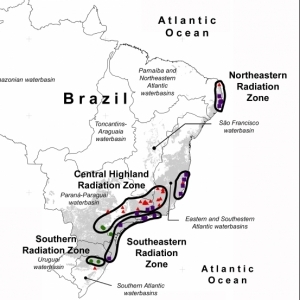Notícias
Paper led by Dr. Markus Gastauer has been published by Ecology and Evolution
publicado em
The hypothesis of Sympatric Speciation as the dominant Generator of Endemism in a Global Hotspot of Biodiversity
Markus Gastauer1,3*, Amílcar Walter Saporetti-Junior1,3, Luiz Fernando Silva Magnago1,3, Jeannine Cavender-Bares2 and João Augusto Alves Meira-Neto1,3*
Allopatric or sympatric speciation influence the degree to which closely related species coexist in different manners, altering the patterns of phylogenetic structure and turnover among and between communities. The objective of this study was to show if sympatric or allopatric speciation are the dominate patterns for the formation of extant angiosperm richness in the Brazilian Atlantic Forest. Therefore, we analyzed phylogenetic community structure (MPD, MNTD) as well as taxonomic (Jaccard similarity) and phylogenetic turnover (betaMPD, betaMNTD) among and between 49 tree communities distributed among three different habitat types. Mean annual precipitation and mean annual temperature in each survey area were estimated. Phylogenetic community structure does not differ between habitat types, although MPD reduces with mean annual temperature. Jaccard similarity as well as betaMNTD increase with spatial distance and environmental differences between study sites. Spatial distance explains the largest portions of variance in the data, indicating dispersal limitation and the spatial aggregation of recently formed taxa, as betaMNTD is related to more recent evolutionary events. betaMPD, that is related to deep evolutionary splits, shows no spatial or environmental pattern, indicating that older clades are equally distributed across the Brazilian Atlantic Forest. Similarity and betaMNTD patterns may be explained by dispersal limitation triggering sympatric speciation, thus generating extant diversity and endemism in the Brazilian Atlantic Forest. Low dispersal still allowed older clades to disperse and become widespread, as indicated by betaMPD. More comprehensive approaches are necessary to reduce spatial sampling bias, uncertainties regarding angiosperm diversification patterns and confirm our conclusions for further taxonomic groups.
Keywords:Spatial phylogenetic turnover, species formation, dispersal limitation, similarity, phylogenetic community structure, Brazilian Atlantic Forest.